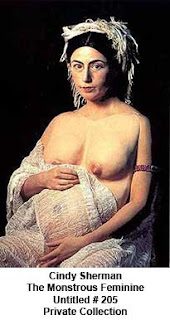Michelle
Obama, Fuzzy Jesus, and the Value of Art
It’s the Republican Convention (yawn, stretch, snooze), so I
want to think about something else.
This week, there’s been a micro-explosion of news-garnering art
alteration, most notably an octogenarian’s hilariously mishandled ‘restoration’ of
a 19th-century Spanish wall painting of Jesus (bottom triptych, above). But Spain has given us another
fascinating case, one that isn’t yet as well-reported as is the Simian
Christ. It’s a cover for the Magazine de Fuera de Serie. The artist is Karine Percheron-Daniels, who
photo-chopped Michelle Obama’s head (top left, above) into an 1800 oil portrait of a Caribbean slave (top right, above).
To me, the interesting thing about Fuzzy Jesus (after
initial delight in the bizarre horridness of the paint-over) is the reaction to
it. Overwhelmingly, public opinion (at least as we can tell via the internet)
has been on the side of the Ewokian Son of God. There are petitions to save it (after initial calls to
re-restore the conventional painting that it pretty much obliterated). There are mock justifications of its
theological depth, such as that it critiques Bible-based Creationism by
depicting the Christ as, more or less, the Missing Link. There are less ironic justifications of
the botch-job, such as it is a subtle (???!!!) commentary on the unconsidered
transmission of visual tropes and a jab at the authority of the art-historical
canon. There are capitalist
reception-theory views of the work, such as noting that tourists are flocking
to the previously obscure site in order to view the new objet célèbre, in the process bringing much-needed cash to the church and
the town. And there are the rather
plaintive calls by relatives of the 19th-century artist, Elias
Garcia Martinez, to restore/recreate the original, not to mention municipal
threats to charge the aged ‘restorer’ with vandalism.
Upshot? The Santuario
de Misericordia in Borja, Spain, is experiencing a decided uptick in visitors,
Elias Garcia Martinez has been catapulted from (to me) deserved obscurity (the
painting was not only derivative, it was done badly – painted directly onto the
wall as opposed to a prepared surface, which is why it had flaked away so
quickly) into art-historical recognition, and the ‘restorer’ will no doubt reap
monetary rewards (paid interviews if nothing else) from her brush-wielding
intervention. Win – win – win!
Let’s switch to the Michelle Obama-as-slave/courtesan
magazine cover. Again, this is an
‘art intervention,’ here using modern (Photoshop and its clones) rather than
traditional (brush and paint) tools to modify a previously existing image. The original, painted by Marie-Guilhelmine
Benois in 1800, lives in the Louvre (probably in the Louvre’s storage
facilities, as I doubt it has been on permanent display recently [but that may
change]), rather than on a church wall.
Benois was a pupil of the neo-classicist master Jacques-Louis David, and in its time, her painting
was relatively well known but subsequently consigned to the obscurity that the
art-historical canon can so readily confer, particularly (until recently, perhaps) on female artists.
The controversy, such as it is, about the Michelle Obama
cover is whether it repeats and exploits racist and sexist stereotypes. The first: the artwork depicts the First Lady as a slave or at least as a
newly emancipated 'fancy woman.' The
second: the artworks sexualize both subjects, as evidenced by the exposed breast (different online reports on the cover
show it with a blurred torso or, as in the image I reproduced above, a
‘starred’ nipple).
Nothing I’ve read about the magazine cover is ironic, or
even acknowledges the tantalizingly peculiar disconnect between the present
subject (Michelle Obama) and the original subject (a slave/mistress from
Guadeloupe). Nor do commentaries
(and there aren’t many of them, to date) bother to address what the current artist
thought she was doing with this image or how the magazine, in its article about
Michelle Obama, tried to depict her – not to mention how the original painting
was conceived and received. Instead, the cover is condemned as ‘obviously
offensive’ and ‘racist.’
Some things to think about:
--The Michelle Obama image was not
commissioned by the Spanish magazine. Magazine
Fuera de Serie simply bought the rights to what was part of a preexisting
(and, one assumes, ongoing) series depicting famous contemporary women as
subjects of canonical art works, usually ones featuring the female nude. Example: Queen Elizabeth as a heraldic Renaissance/Baroque emblem.
Another example: Marilyn Monroe
as a classical Odalisque.
--How different is this series from
the works of Cindy Sherman, the most celebrated and highest-priced female
artist (her medium is photography) in the world? Ideologically speaking, not much. ‘Originality’ speaking, Sherman takes the tiara, as her projects
predate Percheron-Daniels. Value-speaking . . . the fact that Sherman’s works have blown the roof
off photographic sales prices (she holds the record at almost $4million per print) makes it an unfair
contest. But if even low-level
controversy is generated by the Magazine
Fuera de Serie cover . . . it’s a good bet that Percheron-Daneie’s prices
will soar. So that’s one aspect of
value.
--How less ‘original’ is this image
from the many riffs on an ‘original’ that are canonized in Western Art
history? It may be less
interesting or well done, but the fact that it’s a riff should not be
disqualifying. As an example, some canonical Odalisques (not counting Marilyn Monroe, above) by (top to bottom) Titian, Ingres, Gauguin, and Matisse:
--The cover image is one thing,
obviously chosen (paid for) to generate interest and sales (value). The article is another. Its subtitle is: “Michelle
Tataranieta De Esclava, Dueña De América” (more-or-less literal
translation: Michelle Great-Great-Granddaughter
of a Slave, Lady of America). It
praises the First Lady (and at least tacitly, the United States), and its slant
is on the huge changes that have affected African American women over two
centuries.
--The Benois painting was meant to
celebrate France’s emancipation of its slaves (although, ironically, that
emancipation did not stick in Guadeloupe for more than a couple of years) and
to celebrate the agency of former female ‘chattel.’ And that’s how it was valued by what was then in Europe the
‘Progressive’ faction.
--As ‘Progressive’ politics have understandably
changed during the 20th and 21st centuries, and as
Feminism has influenced Progressivism, much attention has been focused on how
women – particularly non-white women – are sexualized (to serve the
underpinnings of patriarchy, to serve the gendered ideology of colonialism, to
serve the goals of Capitalism).
Thus, the offending bared nipple.
Thus, the automatic contemporary devaluing of this artwork.
--European art has a long tradition of
female nudes. American (viz, United
States) art has much less of this tradition because of, to simplify, the
Puritan double inheritance of sexual discomfort and iconoclasm (and perhaps
also a general supercilium about European art and its topoi).
Therefore: a devaluing of
nudes, or partial nudes, as artistic subjects.
So should U.S. citizens today be highly offended by the Spanish
magazine cover? I think: no. The image was selected to add value (sales) to a periodical
by, certainly, injecting some look-twice value (if it had been an American
magazine, we would say ‘shock value’) and – who knows – to add value to a
European woman artist who’s done some interesting, if not exactly ground-breaking, projects. I'll go so far as to say that Michelle Obama (pace the offending nipple) looks beautiful, regal, and powerful in this pastiche.
I could even argue that, like Fuzzy Jesus, the image
deliberately or non-wittingly challenges artistic and ideological stereotypes,
as well as putting into focus the conditions that determine artistic
‘value.’
As an undergraduate Art History major, I retain vestiges of
‘universal value’ as a silent but deep current of how art is judged. As a person with a doctorate in
literature and literary theory (and as someone who’s considerably older than
she was as an undergraduate), I doubt the validity of ‘universal value.’ But doubting ‘universal value’ as a
given truth, like the law of gravity or the inevitability of death, does not
mean doubting ‘value’ as an important part of how we see ourselves and our
world and our art and even our beliefs.
In whatever realm of endeavor and existence, thinking about
value . . . what one means by value . . . who does the valuing . . . what
forces influence valuation . . . is, to me, a good thing. Thus, at least transient salute to
Fuzzy Jesus and to Pecheron-Daniels’ ‘portrait’ of Michelle Obama for making me think, and think
again.
So, for the final rethink (for tonight): the Santuario de Misericordia Jesus 'restoration' is pure kitsch -- something so aesthetically atrocious that it's compelling. Its value (as 'ironic art,' as tourist attraction) will be fleeting. In contrast, Karine Percheron-Daniel's work has serious conceptual weight, even if it's not altogether novel, even if its medium is not yet seen as fine-art-ish and, frankly, even if its craft is a bit shaky (the color tones of the superimposed head and the pre-existing body do not match very well). So, despite its shortcomings, I'd rate it higher as a potentially valuable work of art. But then again, we can't underestimate the power of a haunting image like Fuzzy Jesus, particularly if it goes viral in today's unexplored terrain of virtual value-creation. Who will ever forget this image, and isn't remembering beyond the fifteen-minutes of fame Warhol allotted (back in the pre-internet days) the sign of something . . . valuable?
So, for the final rethink (for tonight): the Santuario de Misericordia Jesus 'restoration' is pure kitsch -- something so aesthetically atrocious that it's compelling. Its value (as 'ironic art,' as tourist attraction) will be fleeting. In contrast, Karine Percheron-Daniel's work has serious conceptual weight, even if it's not altogether novel, even if its medium is not yet seen as fine-art-ish and, frankly, even if its craft is a bit shaky (the color tones of the superimposed head and the pre-existing body do not match very well). So, despite its shortcomings, I'd rate it higher as a potentially valuable work of art. But then again, we can't underestimate the power of a haunting image like Fuzzy Jesus, particularly if it goes viral in today's unexplored terrain of virtual value-creation. Who will ever forget this image, and isn't remembering beyond the fifteen-minutes of fame Warhol allotted (back in the pre-internet days) the sign of something . . . valuable?















